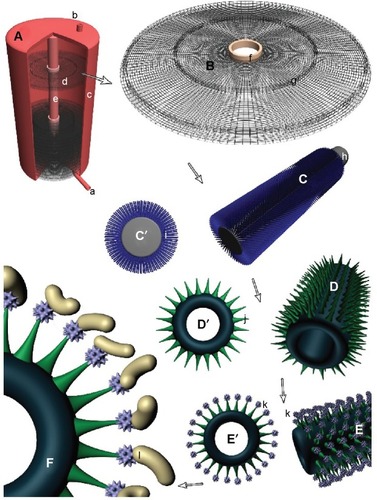Figures & data
Figure 1 Schematic diagram of proposed setup for prospective auxiliary treatment of sepses.
Notes: It uses BPVAC for removing BATs from the blood of septic patients. BPVAC would work aseptically with the aid of a blood pump in a closed circuit. Main features of the treatment would include (A) hand of septic patient, (B) blood removed from artery, (C) arterial pressure monitor, (D) inflow sampling to detect BATs titer before processing, (E) heparin pump (to prevent clotting), (F) peristaltic blood pump, (G) pressure monitor indicating outflow pressure from the blood pump, and (H) BPVAC, the central component of the treatment, designed to trap and immobilize BATs from infected blood. BATs would adhere to BATs-antibodies, and hence, would be trapped inside the column. (I) pressure monitor indicates outflow pressure from BPVAC, (J) air detector and air trap, (K) outflow sampling to monitor BATs titer by appropriate serological tests, and (L) detoxified blood returns to the vein. All tubing and BPVAC would be applied aseptically; however, they are single-use and would be properly disposed of after treatment.
Abbreviations: BPVAC, bacterial polyvalent antibody-column; BATs, bacterial antigens and their toxins.
Abbreviations: BPVAC, bacterial polyvalent antibody-column; BATs, bacterial antigens and their toxins.

Figure 2 Prospective structural components of a BPVAC.
Notes: BPVAC traps and withdraws BATs in an extracorporeal manner from the blood of septic patients with the help of a blood-circulating machine. (A) Dissected BPVAC, consisting of (a) inlet (intoxicated blood from septic patient enters the column by the help of blood-circulating machine), (b) outlet (detoxified blood leaves the column to return back to the patient), (c) column cylinder, (d) MAPs, and (e) center axis (stacks MAPs in place). (B) A MAP (manufactured from biocompatible organic polymers consisting of an extensive lattice); it bears center spacer (f) and lateral spacers (g) (to keep the MAPs apart). Lattice frame is composed of subunits. (C) A lattice subunit (h). (C′) Cross-section of a lattice subunit bearing millions of nano carbon-rods (i) on its surface. (D) Surface topology of a nano carbon-rod (antibody–antigen reaction platform). (D′) Cross-section of a nano carbon-rod harboring antibody conjugated moieties (j). (E) Antibodies conjugated to supporting moieties. (E′) Monovalent antibodies (k) adhered to moieties. (F) BATs (l) trapped to their antibodies and removed from the blood. Detoxified blood returns back to the patient.
Abbreviations: BPVAC, bacterial polyvalent antibody-column; BATs, bacterial antigens and their toxins; MAPs, monovalent antibody plates.
Abbreviations: BPVAC, bacterial polyvalent antibody-column; BATs, bacterial antigens and their toxins; MAPs, monovalent antibody plates.

